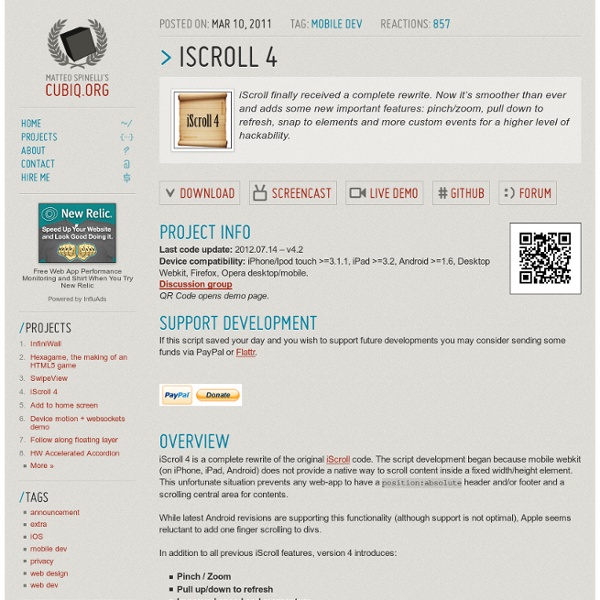Tracking Touch Events on the iPad « The HTML Pad
February 12, 2010 by thethirdamigo Touch events on the iPad work like they do on the iPhone. You can attach event listeners two DOM elements and have listeners called when an event occurs. Basically what you need to do is : 1) Attach a listener to an element <div id="_mcePaste"><div id="box" style="height:225px;width:225px;background:red;position:absolute"</div><div>ontouchmove="touchMove(event)"</div><div>ontouchstart="touchStart(event)"</div></div> 2) Do something when an event occurs function touchStart( e ) { var box = document.getElementById("box"); box.style.background = "green"; e.preventDefault(); return false; } function touchMove( e ) { var targetEvent = e.touches.item(0); var box = document.getElementById("box"); box.style.background = "yellow"; box.style.left = targetEvent.clientX + "px"; box.style.top= targetEvent.clientY + "px"; e.preventDefault(); return false; } I have created a full working example with source here. Like this: Like Loading...
HOWTO: Native iPhone/iPad apps in JavaScript
More resources On top of the information below, I can recommend a few other resources: Building iPhone Apps with HTML, CSS, and JavaScript is the only book I found that covered everything. I highly recommend it if you're planning on doing serious app development in JavaScript. Making it full-screen Normally, if you press "+" in mobile Safari and then "Add to Home Screen," the icon it creates acts like a bookmark into Safari. To get rid of the URL and button bars, just add a meta tag: This is what my log app looks like when launched from the home screen: Changing the phone status bar You can also change how the phone's status bar is displayed with a meta tag. The values for content are default, black and black-translucent. Preventing scaling If you pinch on a web app, it still responds like it's in a browser and zooms in. You'll almost certainly want to set the viewport width to the device width as well, so that the app shows up at its natural resolution. Preventing elastic scrolling Confused?
Luxembourg, Centre d'affaire, Domiciliation, Création de société, Immatriculation, Secretariat, Comptabilité, Services VIP
BreakTime – You need a break
Twitter: quelques outils et astuces pour votre prochain événement
Lorsque vous organisez un événement, les médias sociaux et en particulier Twitter sont une excellente façon de le faire rayonner. Encouragez vos participants à publier sur les médias sociaux leurs commentaires et réactions. Ainsi, après votre événement, vous pourrez analyser l’impact et reprendre les publications de vos participants. La journée de l’événement, Twitter est à mon avis l’application la plus intéressante. Je vous suggère donc quelques outils qui peuvent vous aider à propulser votre événement et ainsi le faire connaître aux réseaux de contacts de vos participants. Avant toute chose, créer un compte Twitter pour votre événement. Affichez les tweets des participants Prévoyez un projecteur multimédia qui diffusera les tweets de vos participants. Utilisez les codes QR Les codes QR vous permettent de préparer des messages que les participants pourront envoyer sur Twitter tout simplement en balayant le code QR. Inscrivez le hashtag sur les cocardes Vous me direz que c’est évident.
Nettoyez votre Mac
Si vous utilisez OSX et que vous cherchez un bon petit soft capable de faire un petit cleanup, de vous dire ce qu'il y a dans les entrailles de votre Mac, à savoir la config hardware exacte, les logiciels, plugins, widgets installés ou encore les process et les fichiers ouverts, j'ai ce qu'il vous faut : Magican Avec Magican, il est possible d'avoir tout un tas d'infos (CPU, RAM, T°, vitesse du disque dur, du ventilo, du réseau...etc.) mais aussi de désinstaller des softs proprement (pratique pour les widgets et les plugins. On gagne du temps.). On peut voir aussi quelles sont les connexions initiées et utilisées les logiciels qui tournent, tuer des process et surtout faire le grand ménage sur votre disque dur ! Magican propose en effet une fonction de nettoyage qui permet de dégager (au choix) les fichiers doublons, les logs et caches qui bouffent trop de place, les langues non utilisées ou encore les binaires qui ne servent à rien, car destinés à du PowerPC. [Source et photo]



